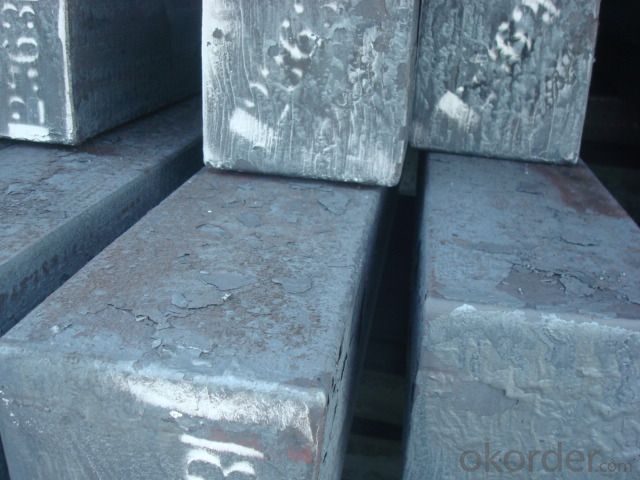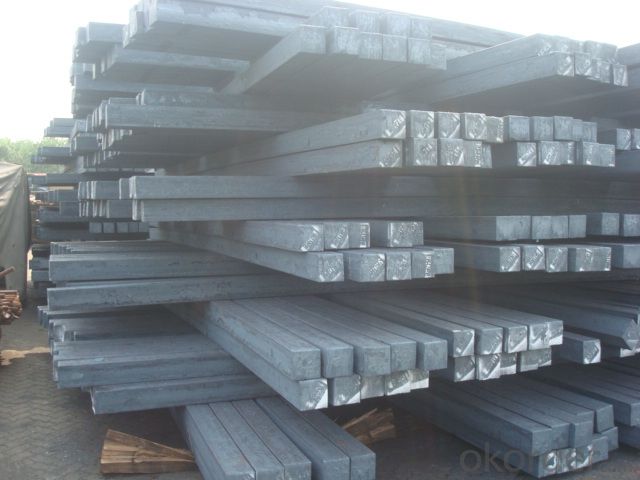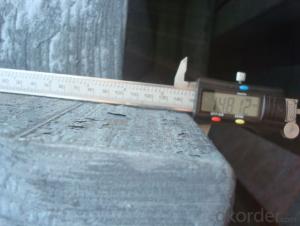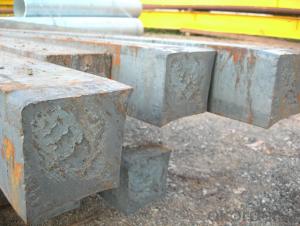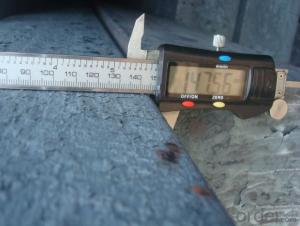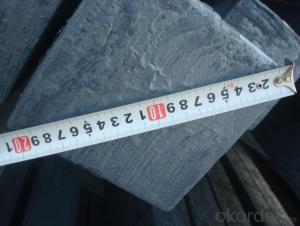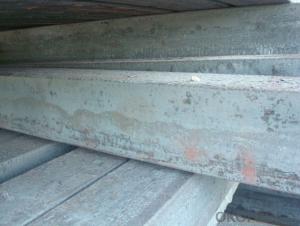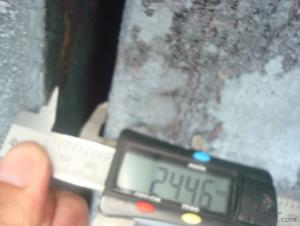Steel Bloom Manufactured by Big Blast Furnace
- Loading Port:
- Tianjin
- Payment Terms:
- TT OR LC
- Min Order Qty:
- 1000 m.t.
- Supply Capability:
- 100000 m.t./month
OKorder Service Pledge
OKorder Financial Service
You Might Also Like
Steel Bloom Manufactured by Big Blast Furnace
1.Structure of Steel Bloom Manufactured by Big Blast Furnace
Steel Bloom Manufactured by Big Blast Furnace is the raw material of all kinds of steel mill. Billet section of square, round, flat, rectangular and abnormity, etc Several, mainly related to shape of rolled products. Simple rolled section steel, choose cross section of square billet or rectangular billet. rolling The sector products such as flat steel, Angle steel, select the rectangular billet or slab. Had better profiled billet when production beams, channels, and in rolling process Lines and improve the yield. The raw material of round billet is the production of seamless tube.
2.Main Features of Steel Bloom Manufactured by Big Blast Furnace
Steel Bloom Manufactured by Big Blast Furnace section size should meet the requirements of rolling deformation and finished product quality, but also roll strength and biting condition of restrictions. General steel Billet section height H. And the roll diameter D The ratio of the ( namely H/D) Should be less than or equal to zero 0.5 . Length of steel billet by finishing temperature, Rolling time and the length of the product Or times ruler. When heated too long accident prone to bump the furnace wall of steel, too short, furnace bottom utilization rate is not high, influence the heating furnace production. For the production Choose a variety of steel and steel billet, should consider the affinities of billet, as far as possible in order to improve the productivity of the roughing mill, simplify the stock management of workshop.
3. Steel Bloom Manufactured by Big Blast Furnace Images

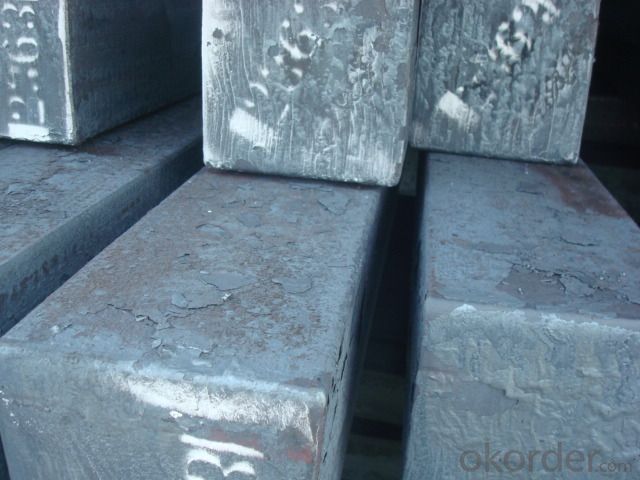
4. Steel Bloom Manufactured by Big Blast FurnaceSpecification
Steel Billet Manufactured by Blast Furnace rolled steel, after processing can be used for mechanical parts, forging parts, processing all kinds of steel, steel Q345B channel steel, wire rod is the role of the billet. Steel billet is used in the production of semi-finished products, generally cannot be used directly for the society. Steel billets and steel are strictly divided into standard, cannot decide to whether the business enterprise of the final product, and according to unified standards to perform the whole society. Typically, billet and the steel is relatively easy to distinguish, but for some steel billet, and have the same specification and same steel purposes (such as rolling tube billet), whether can be used for other industries, whether through steel processing process, whether through a finished product rolling mill processing to distinguish
Material standard The editor Range of thickness: 150-240 - mm + / - 5 mm width range: 880-1530 - mm + / - 20 mm Length: 3700-10000 - mm + / - 500 - mm Cross-sectional size: 64 * 64; 82 * 82; 98 * 98; 124 * 124; 120 * 150; 152 * 164; 152 * 170 mm Length: 9000 mm Section of tolerance: billet: 1.0 + / - 2.0-1.0 + / - 1.0 mm slab: width: + / - 2.0 mm thickness: + / - 3.0 mm The length tolerance: + / - 200 mm Section diagonal tolerance: 3.5-8.0 MM Billet section size protrusions requirements: < 1242 mm, do not allow; > = 1242 mm, < = 2 mm 1242 mm, < = 3 mm Beheading (shear) extension deformation: < 1242 mm billet: no control; The slab: < = 15 mm Surface tilt: no more than billet section 0.1 Bending: every 1 m length is not more than 10 mm The distortion: length < = 5 m, < = 11. ; The length of the < = 7.5 M, < = 5. Material % 3 sp/PS chemical composition: C Mn Si S P
5.FAQ of Steel Bloom Manufactured by Big Blast Furnace
①How about your company?
A world class manufacturer & supplier of castings forging in carbon steel and alloy steel,is one of the large-scale professional investment casting production bases in China,consisting of both casting foundry forging and machining factory. Annually more than 8000 tons Precision casting and forging parts are exported to markets in Europe,America and Japan. OEM casting and forging service available according to customer’s requirements.
②What is the advantage of the continue Casting steel Bloom comparing to the die casting steel Bloom?
Compared with die casting, continuous casting has the advantages of: 1. To simplify the Steel Bloom The production process 2. Improve the metal yield 3. Improve the quality of the Bloom 4. Reduces the steel worker's labor intensity 5. Save energy and reduce consumption
Steel Bloom is produced by the method of through three processes: It is through the steelmaking system of continuous casting equipment, directly by the molten steel pouring into Bloom; The second is the steelmaking system in the production of steel ingot casting Bloom through system of steel rolling rolling equipment or processing of steel semi-finished products; Three is the steelmaking system production of steel ingot by forging the semi-finished product processing equipment.
③How about the Q235 Grades?
Q235:A、B、C、D(GB700-88)
Q235A:C0.14~0.22% Mn0.30~0.65Si≤0.30S≤0.050P≤0.045
Q235B:C0.12~0.20% Mn0.30~0.670Si≤0.30S≤0.045P≤0.045
Q235C:C≤0.18% Mn0.35~0.80Si≤0.30S≤0.040P≤0.040
Q235D:C≤0.17% Mn0.35~0.80Si≤0.35S≤0.040P≤0.035
- Q: What are the different types of surface treatment methods used for steel billets?
- Steel billets can undergo various surface treatment methods to serve specific purposes. Here are some commonly employed techniques: 1. Pickling: By immersing steel billets in an acidic solution, typically hydrochloric or sulfuric acid, any scale or oxide layers on the surface can be eliminated. Pickling enhances the surface finish and readies the steel for further processing. 2. Shot Blasting: This method involves propelling high-velocity small metal or ceramic particles onto the steel billet surface. The process effectively removes rust, scale, and contaminants, resulting in a clean and smooth finish. 3. Grinding: To eradicate imperfections from the steel billet surface, mechanical abrasive wheels are utilized. Grinding can achieve a specific surface roughness, making it ideal for precision and accuracy requirements. 4. Acid Etching: By applying an acid solution to the steel billet surface, a controlled roughness or texture can be created. This enhances subsequent coating or paint adhesion. 5. Galvanizing: A layer of zinc is applied to the steel billets in this popular method. Zinc acts as a sacrificial barrier, providing excellent corrosion resistance and protecting the underlying steel from oxidation. 6. Powder Coating: Electrostatically applying a dry powder to the steel billet surface characterizes this technique. Upon heating, the powder melts and forms a protective layer known for its durability, corrosion resistance, and ability to offer diverse decorative finishes. 7. Passivation: This chemical process aims to enhance the corrosion resistance of stainless steel billets. It involves eliminating iron contaminants and forming a passive oxide layer that safeguards the steel from oxidation. These examples represent only a fraction of the surface treatment methods available for steel billets. The selection of a method depends on factors like desired surface finish, intended steel application, and required level of corrosion resistance.
- Q: What are the main factors affecting the machined surface quality of steel billets?
- The main factors affecting the machined surface quality of steel billets include the choice of cutting tool, cutting parameters such as cutting speed, feed rate, and depth of cut, the composition and properties of the steel billet, and the presence of any surface defects or impurities.
- Q: The form of carbon in carbon steels
- The solubility of carbon content when the iron carbon alloy than in the iron when the excess carbon can be in the form of carbide iron or elemental state (graphite) in alloy, which can form a series of carbide, Fe3C (cementite, 6.69%C) is a metastable phase, it is a compound complex structure gap. Graphite is a stable phase of iron carbon alloy with simple six - party structure. Fe3C has the potential to break down into iron and graphite stable phases, but the process is extremely slow at room temperature.
- Q: What are the main factors affecting the machinability of alloy steel billets?
- The main factors affecting the machinability of alloy steel billets include the composition of the alloy steel, the heat treatment it has undergone, the hardness of the material, the presence of impurities or inclusions, and the cutting parameters used during machining such as cutting speed, feed rate, and depth of cut.
- Q: How do steel billets contribute to the manufacturing of marine equipment?
- Steel billets are an essential raw material in the manufacturing of marine equipment. They serve as the starting point for various processes such as rolling, forging, and machining, which shape the billets into the desired components. These components, made from high-quality steel, provide strength, durability, and corrosion resistance necessary for marine equipment, ensuring their safe and reliable operation in challenging maritime environments.
- Q: What are the different types of defects that can occur in steel billets?
- There are several types of defects that can occur in steel billets. These defects can occur during the manufacturing process or as a result of external factors. Some of the common types of defects include: 1. Surface defects: These defects occur on the outer surface of the billet and can include scratches, pits, scabs, scale, and cracks. Surface defects can be caused by handling, improper cooling, or contamination during manufacturing. 2. Internal defects: These defects occur within the body of the billet and are not visible on the surface. They can include voids, porosity, inclusions, and segregation. Internal defects can be caused by improper solidification, improper casting, or impurities in the steel. 3. Dimensional defects: These defects occur when the billet does not meet the desired dimensions or tolerances. Dimensional defects can include variations in length, width, thickness, or straightness. These defects can be caused by improper rolling, uneven cooling, or misalignment of the equipment. 4. Mechanical defects: These defects affect the mechanical properties of the steel billet. They can include improper grain structure, low hardness, brittleness, or poor toughness. Mechanical defects can occur due to improper heat treatment, incorrect alloy composition, or inadequate rolling processes. 5. Weld defects: In case of welded billets, defects related to the welding process can occur. These defects can include lack of fusion, incomplete penetration, porosity, or cracks in the weld zone. Weld defects can be caused by improper welding parameters, inadequate preparation, or contamination during the welding process. It is important to detect and address these defects to ensure the quality and integrity of the steel billets. Various inspection techniques such as visual inspection, ultrasonic testing, magnetic particle testing, or radiographic testing can be employed to identify and classify these defects.
- Q: How are steel billets used in the manufacturing of agricultural machinery?
- Steel billets are often used as a starting material in the manufacturing process of agricultural machinery. They are typically shaped and transformed through various machining and forging techniques to create different components like gears, shafts, brackets, and frames. These components are then assembled to build the necessary machinery for farming operations, such as tractors, tillers, harvesters, and irrigation systems. The use of steel billets ensures durability, strength, and reliability in agricultural machinery, making them capable of withstanding the demanding conditions and heavy workloads often encountered in the agricultural industry.
- Q: How are steel billets used in the production of building facades?
- Steel billets are an important component in the production of building facades due to their versatility and strength. Building facades are the external covering or cladding of a building, which not only provides an aesthetic appeal but also serves as a protective barrier against external elements. Steel billets, which are semi-finished steel products, are used in the production of building facades in several ways. Firstly, they are often used as the primary material for the structural framework of the facade. Steel billets are known for their high strength-to-weight ratio, making them an ideal choice for supporting the weight of the facade and providing structural stability to the building. Additionally, steel billets can be further processed to create various shapes and profiles required for the design of the facade. These shapes can be formed through processes such as hot rolling, cold rolling, or extrusion, allowing for intricate and customized designs. This flexibility in shaping steel billets enables architects and designers to create unique and aesthetically pleasing facades that enhance the overall appearance of the building. Steel billets are also used in the production of curtain wall systems, which are commonly utilized in modern building facades. Curtain walls are lightweight, non-structural cladding systems that are attached to the building's structural framework. Steel billets are often utilized in the creation of curtain wall support systems, providing the necessary strength and durability to withstand wind loads, seismic forces, and other external pressures. Moreover, steel billets can be coated or treated with various finishes to enhance their corrosion resistance and improve their longevity. These finishes can range from galvanization to powder coating, ensuring that the building facade remains durable and aesthetically appealing over time. In summary, steel billets play a crucial role in the production of building facades by providing strength, flexibility in design, and durability. Their utilization in the structural framework, creation of customized shapes, support systems for curtain walls, and application of protective finishes make them an indispensable material in the construction industry.
- Q: What is the role of steel billets in the manufacturing of hydraulic systems?
- The manufacturing of hydraulic systems heavily relies on steel billets, which have a crucial role to play. These billets serve as the raw material used for creating various components and structures within these systems. In order for hydraulic systems to function properly, it is imperative for their components to possess qualities such as strength, durability, and resistance to corrosion and pressure. Steel billets, due to their exceptional strength and toughness, are the perfect starting material for manufacturing hydraulic system components. Typically made from carbon steel, these billets offer excellent mechanical properties, including high tensile strength and hardness. These properties ensure that the components can endure the high pressures and forces encountered within hydraulic systems without deforming or failing. Furthermore, steel billets undergo several manufacturing processes such as forging, machining, and heat treatment in order to shape them into the desired components. These processes enable the creation of intricate designs and precise dimensions, guaranteeing a proper fit and functionality within the hydraulic system. Additionally, steel billets are renowned for their excellent resistance to corrosion, an essential quality in hydraulic systems due to the presence of fluids and potential exposure to moisture. Corrosion can lead to component failure, leaks, and a decrease in system performance. By utilizing steel billets, these issues can be prevented, ensuring the longevity and reliability of the hydraulic system. To sum up, steel billets are indispensable in the manufacturing of hydraulic systems as they provide the necessary strength, durability, and resistance to corrosion required for the components within these systems. Their versatility and ability to be shaped and processed make them an ideal material choice for creating reliable and efficient hydraulic systems.
- Q: What are the different shapes of steel billets?
- Steel billets come in a variety of shapes and dimensions, depending on their intended use and production process. Some common shapes of steel billets include square, rectangular, round, and hexagonal. Square billets are typically used in the construction industry for making beams, columns, and other structural components. Rectangular billets are also used in construction but are often preferred for applications requiring a specific width-to-height ratio, such as window frames or door frames. Round billets are commonly used in the manufacturing of pipes, tubes, and shafts due to their symmetrical shape and ability to withstand torsional forces. Hexagonal billets, on the other hand, find applications in industries such as automotive and aerospace where their unique shape provides enhanced strength and stability. Overall, the shape of a steel billet is chosen based on the specific requirements of the final product and the manufacturing process involved.
Send your message to us
Steel Bloom Manufactured by Big Blast Furnace
- Loading Port:
- Tianjin
- Payment Terms:
- TT OR LC
- Min Order Qty:
- 1000 m.t.
- Supply Capability:
- 100000 m.t./month
OKorder Service Pledge
OKorder Financial Service
Similar products
Hot products
Hot Searches
Related keywords


